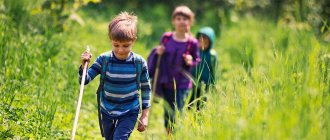Why do we need table rules?
Compliance with rules and etiquette at the table is not the prerogative of a certain social group of people. It has nothing to do with the level of income or social status of the family. “We are from simple people, from workers. Why do we need all these tablecloths, napkins, forks and knives? Why does my child need all this? “Kindergarten teachers sometimes hear something similar. It is important to understand that the culture of nutrition and behavior is not whims, not the desire to “show off” in front of others. The fact is that following certain rules of etiquette at the table makes sense and has specific benefits for children. Let's look at some of them:
- Washing your hands before eating protects the body from pathogenic bacteria entering with food;
- Setting the table using a clean tablecloth and disposable napkins protects food from coming into contact with the surface of the dining table;
- The requirement to “not fidget” and not talk while eating is to prevent serious incidents at the table (the child may choke);
- The request to “take your time,” sit up straight and chew your food thoroughly is nothing more than helping the stomach digest what you eat quickly and easily;
- A napkin placed on your knee (or chest) will protect your clothes from getting dirty.
Museum: Rules of conduct for children
I would especially like to highlight the use of special cutlery during meals. Many still believe that this is nothing more than deliberate behavior of the upper class, in order to show their skills and knowledge in this area. It's not like that at all. To use devices skillfully, you do not need to be a representative of a certain group. The use of devices is not intended to exhaust, but to facilitate the actions of the eater . It is much more convenient to eat meat by cutting it into pieces (rather than biting whole with a fork), it is convenient to cut fish with a special fork, and eat dessert with a small spoon or fork. It's true?
Deadline Topic Goal September 1 Conversation “Rules Form rules of behavior in the group
Transcript
1
2 Deadline Topic Goal September Conversation “Rules Form rules of behavior in a group Behavior in a group” Conversation “Rules of behavior on the site” Game situation: “Are we doing the right thing.” Conversation “Where you can and cannot play.” Game situations “Let’s wash the doll Katya.” Creative game: “Fruit and Vegetable Store.” Game "Let's go to the forest to pick mushrooms." Excursion to the medical office. Role-playing game “Hospital”, “Vegetable Store”. Form rules of behavior on the site, know the location of your site; be able to navigate the area Continue to introduce children to the basic rules of behavior in kindergartens: play with children without disturbing them or causing pain; do not talk to strangers and do not take treats or various items from them. Introduce children to what can happen if you go for a walk alone. October Form ideas about health and a healthy lifestyle. To form an idea of the benefits of vegetables and fruits for the body. To enrich children’s understanding of the gifts of autumn in the forest. To emphasize the importance for health of eating well and keeping one’s body clean. Introduce healthy foods, their importance for health and good mood. November Game-conversation “How to form the habit of handling pets with care.” Conversation “About strangers” Explain to children that it is forbidden to approach strangers Didactic game “Can’t” Clarify children’s knowledge about the concepts of “can” and “can’t” Conversation “About Explain to children what is pleasant
3 discrepancy between pleasant appearance and good intentions" Reading the Russian folk tale "The Wolf and the Seven Little Goats" Conversation "If you are alone at home" Conversation "Dangerous situations in the kitchen" Conversation "Be careful with open fire." Game-conversation “Blizzard-blizzard”. Examination of illustrations; photos, guessing riddles of descriptions; children's drawings "Winter fun". Conversation “Caution, ice!” Conversation: “What kind of snow is there?” The appearance of a stranger does not always mean his good intentions. December Bring children to the concept that they cannot leave the house, group, or site without permission; talk to strangers. Foster a sense of self-preservation. To form in children basic knowledge about the dangers of pranks with fire. To teach children not to approach fire, to remember safety rules. January Give children knowledge about the rules of behavior during a blizzard, develop the power of their voice. Develop the ability to behave carefully on a slide! dress warmly so as not to get frostbite when trouble occurs; call adults for help; develop the skill of safe behavior on the road during icy conditions. Give children the concept of snow and safe behavior while walking. Conversation “Don’t climb on high objects.” Conversation “A child and his older friends.” Examination of the poster “Dangerous Objects” Conversation “Beware, icicles! February Teach children to navigate in space, to form a conscious attitude towards their health. To develop children’s ability to communicate with teenagers. Strengthen knowledge about dangerous objects. Give children an idea of icicles and the dangers they can pose.
4 Didactic game “Select objects that cannot be touched” Conversation: “We are traveling on a bus” V. Mayakovsky “What is good and what is bad?” Examination of the painting “Cat with Kittens” Conversation “Do not turn on the electric stove” Conversation “Do not eat medicines and vitamins without permission.” Game-situation “Don’t play with matches - it’s dangerous.” Reading S. Marshak “Fire”. Game-conversation; "Beware of insects." Conversation with illustrations: “Wildlife in spring.” Conversation “Items that require caution March Consolidate children’s knowledge about objects that can be dangerous at home. Form rules of behavior in public transport - bus. Lead children in a conversation to the fact that: - every thing in the house should have its place - be careful with the tap, there is hot water! -don’t run on a wet floor Clarify children’s knowledge about pets, their benefits and harms. April Introduce children to objects that cannot be used independently. Form in children the habit of not touching medicines and vitamins without the permission of adults. Give children an idea of the dangers that matches pose; instill in children a sense of self-preservation. Introduce children to the work of S. Marshak “Fire”. Encourage them to carefully examine the illustration, noticing the main details in it. May Give children knowledge of the rules of behavior when meeting different insects. Foster a caring attitude towards nature; teach to feed the birds without reminders and not to break branches. Invite children to remember well the basic items that are dangerous to life and health.
5 appeals"; Conversation “Our friend the traffic light” Continue to introduce children to the work of the traffic light Game training “How to behave on the water, near the water.” Game experiment “Swimming and drowning” (experiments with water) Learning physical exercises “Sea”, recreational minutes “On the Shore” - walking barefoot on pebbles, water, shells Conversation: “The harmful and harmless sun!”, “I’m not afraid of the sun” Conversation: "I'm not afraid of the sun." Game situations. Game "We'll go for a walk in the park." “How we went to visit a neighboring group” June Contribute to the formation of knowledge of the rules of careful and prudent behavior of children near bodies of water. Give an idea of the benefits of water for humans. Give an idea of the benefits of water for humans. July Expand children's understanding of the summer sun. Give children the idea that the sun can be different, and in some cases you need to beware of it. Teach children not to be afraid of insects, introduce them to ways to protect themselves from them. Teach children not to be afraid of the sun's rays, introduce them to ways to protect themselves from them. August Develop in children the ability to behave in public places: do not leave adults! don't be a bully! do not tear the plants! do not litter! Cultivate interest and love for animals. To develop the ability and understanding that in an unfamiliar environment you need to behave with restraint and tact.
History and culture of food
The rules of behavior at the table probably appeared before the table itself. They were not invented by the communists in their unique organization of schools and kindergartens. The first mentions of table etiquette appeared in the ancient world. There is mention of this in the texts of the ancient Sumerians. They say that a person must be highly moral and observe ethical standards - this is what is given to man by the gods and distinguishes people from animals. Failure to comply with the rules of behavior, according to the ancient Sumerians, leads to negativity in his life.
Eating is the most important process. He was always surrounded by all sorts of rituals and rules, strictly regulating who, when, where, what he eats. The first rules were inseparably connected with the family hierarchy, the organization of everyday life, the method of cooking, and even with the food itself. Breaking the rules while eating was considered something unforgivable, shameful, and was condemned (and sometimes punished) at all times, in any culture. Life and a person’s way of life changed, and the rules changed along with it. Family rituals have been displaced and given way to food culture and aesthetics. Rules of conduct at the table are increasingly based on secular ethics rather than on religious and national traditions.







